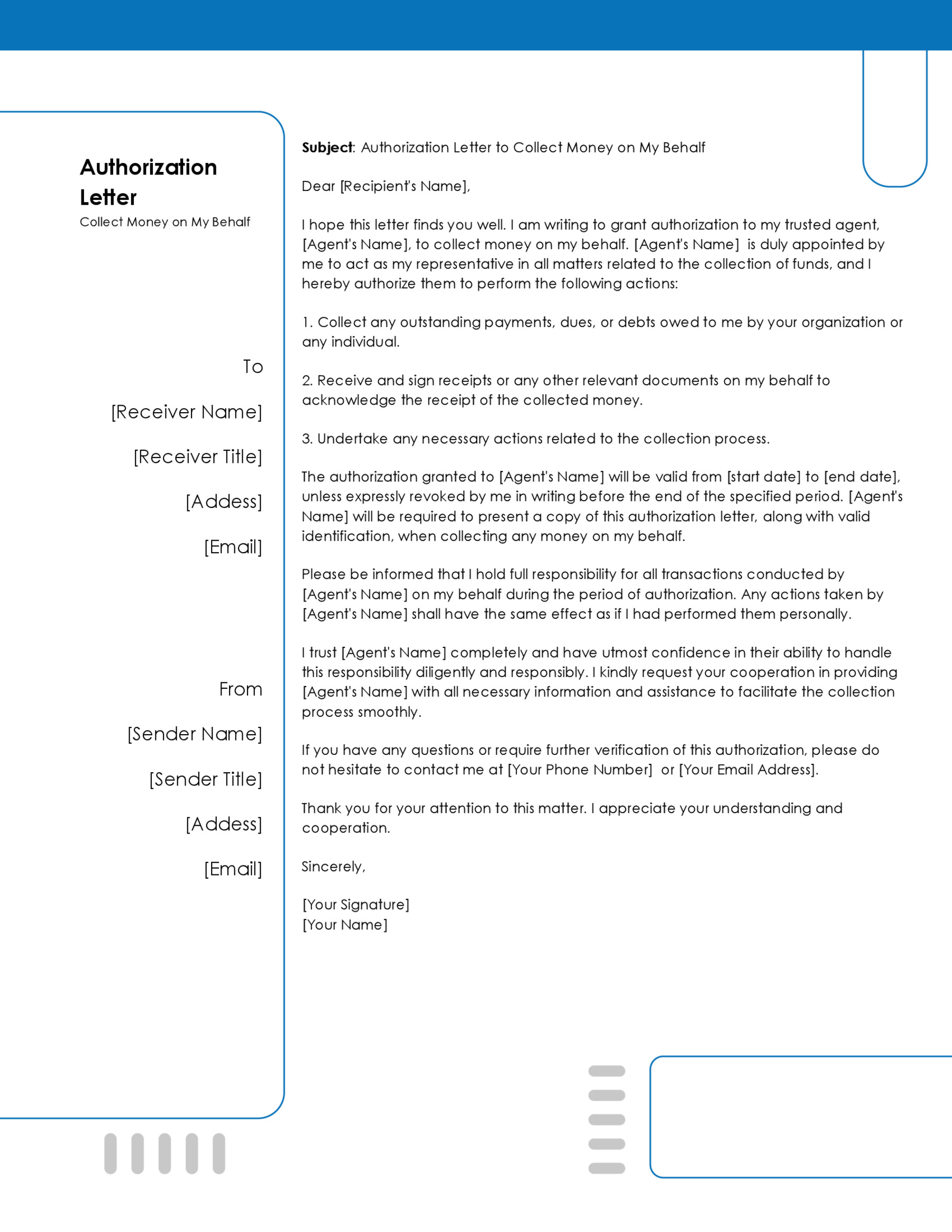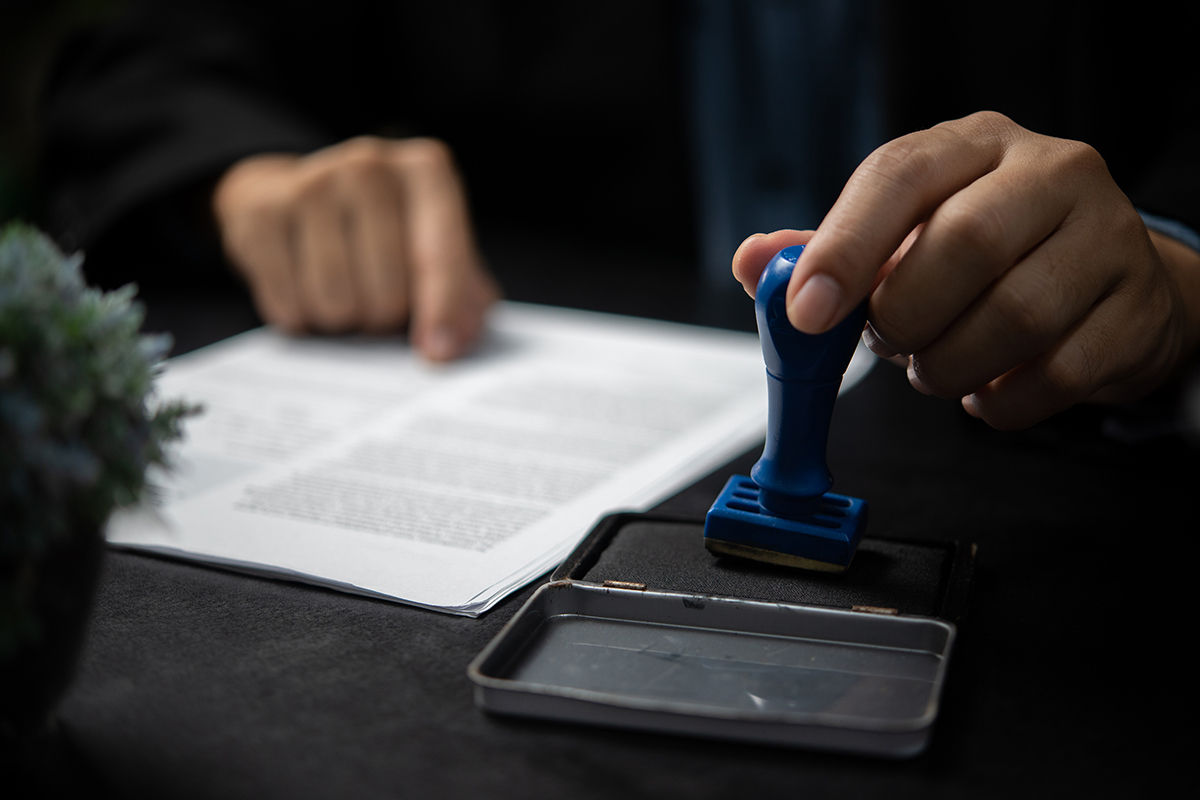As a parent, managing a busy schedule can make it challenging to accompany your child during their travels. Additionally, concerns about their safety and well-being if they go on a trip alone can be overwhelming. To alleviate these fears, employing an authorization letter for your child to travel alone can provide a practical solution. This letter serves as evidence that you, the legal parent or guardian, have granted permission for your child to embark on a solo trip, whether domestically or internationally.
In this comprehensive article, we will guide you through the intricacies of drafting an effective authorization letter. We will discuss the letter’s significance and provide a step-by-step guide to help you craft one. Additionally, we’ve compiled a list of frequently asked questions (FAQs) to address any concerns and provide you the peace of mind you deserve.
What is an Authorization Letter to Travel Alone
An authorization letter to travel is a formal document used by parents or legal guardians to grant consent for their child’s unaccompanied travel, whether within the country or abroad. This legal document informs relevant authorities and entities that a parent or legal guardian has permitted their child to travel without them. The letter contains essential details about the child, the purpose of travel, destination, and stay duration. It may also contain details about the individual, group, or organization accompanying the child if necessary. Because of increased child abduction and trafficking cases, travel companies, airlines, or immigration agents may request this letter from parents if a minor child is traveling unaccompanied.
Authorization Letter to Travel (Templates)




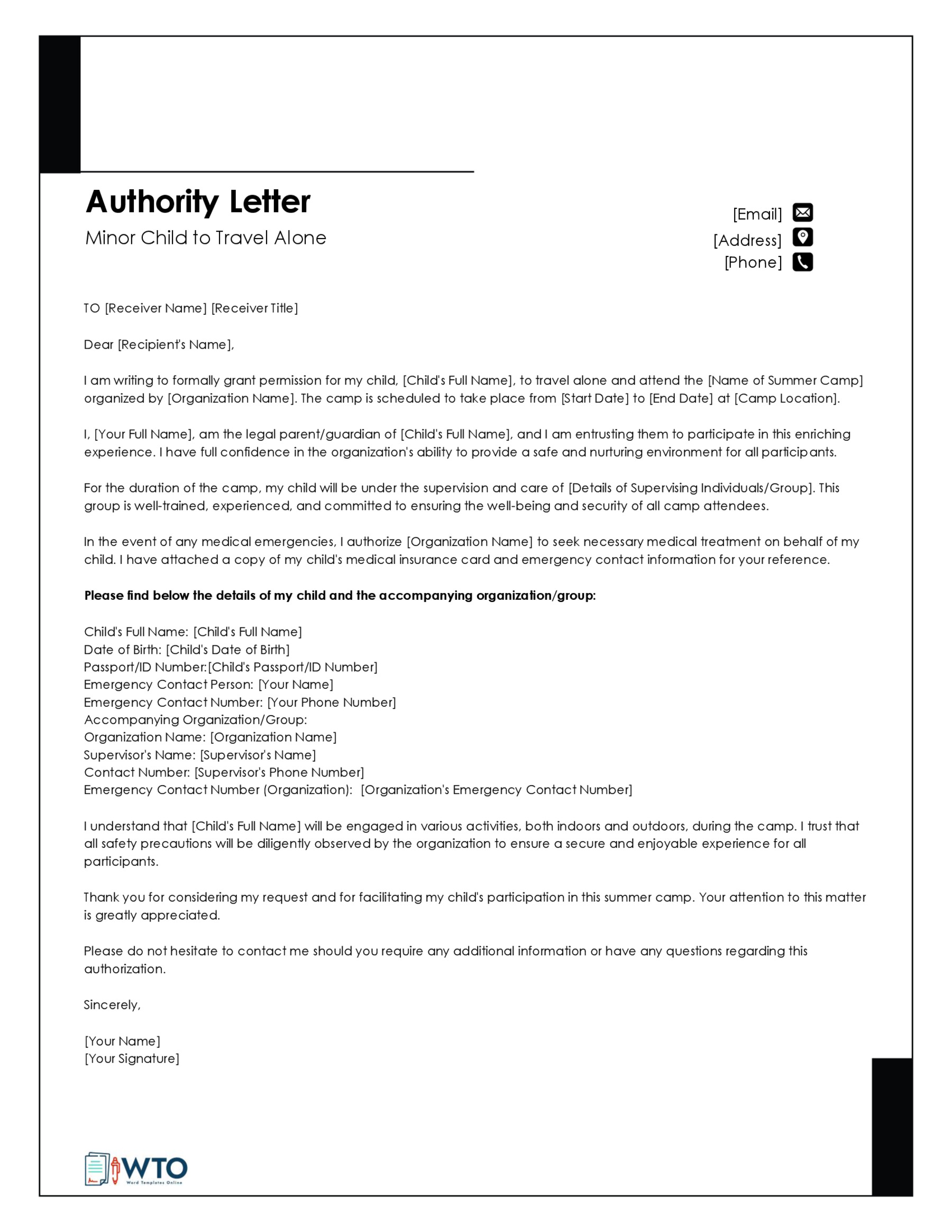

How to Write an Authorization Letter for a Child to Travel Alone
Proof of parental consent is essential for the well-being and safety of your child during their travels. A well-written authorization letter gives this consent in a professional, straightforward manner. Without proof of parental authorization, travel authorities may prohibit your child from proceeding to their destination.
Below is a detailed guide to drafting the authorization letter:
Step 1: Begin with proper formatting
In the top left corner of the page, provide your full name, physical address, phone number, and email address. Follow this with the current calendar date in an easy-to-remember format, such as 09-23-2023 or September 23rd, 2023. Beneath the date, include the recipient’s name, title, organization, physical address, and contact information. The recipient can be an immigration official, airline, or any other relevant authority. This information should be presented in an organized manner to maintain the letter’s professionalism.
For example:
Blaire Anderson
411 W Crawford St.
Saint Louis, Michigan (MI), 48880
anderson.bl342@email.com
(989) 681-8120
May 15th, 202x
Customer Service Desk
Swift Airlines
1209 Duell Rd.
Stanfordville, New York (NY), 12581
info@swiftair.com
(845) 868-7127
Step 2: Address the recipient
Next, address the recipient respectfully using a formal salutation. For example, you may use “Dear [Recipient’s Name]” if you know the recipient personally. Otherwise, you may use “To Whom It May Concern.” A respectful salutation demonstrates your professionalism and creates a positive first impression.
Step 3: Introduce yourself and your child
In the first paragraph, identify yourself as the child’s legal guardian or parent. Follow this with vital information about your child, including their full name, identification (passport or ID number), and date of birth. Conclude the paragraph with a brief statement stating your intention to authorize your child to travel alone.
For example:
I, Blare Anderson, am writing this letter to formally grant authorization for my child, Lucas Anderson, passport number A00000000, to travel alone to Seattle, Washington. Lucas, born on 17th May, 2012, will travel to Seattle to spend the summer with his grandparents. I understand that traveling alone can be a concern, but I am confident in my child’s ability to handle this journey responsibly.
Step 4: Specify travel details
To give the letter a touch of authenticity, provide specific travel details in the next paragraph. Include the destination, departure, and return dates, flight numbers, layovers and, if necessary, details of connecting flights. Ensure this information is accurate to prevent any confusion or misunderstandings.
For example:
Outlined below are the details regarding my child’s trip:
Flight Number: SFA5487
Departure Date: May 20th 202x
Departure Airport: Cherry Capital Airport
Departure Time: 1515 HRS
Arrival Airport: Seattle-Tacoma International Airport
Return Date: August 30th 202x
Layovers: None
Step 5: State the purpose of the trip
The purpose of the trip should be explicitly outlined in the letter. Specify whether your child is attending a school or church event, visiting relatives, or any other reason. Including the purpose of the trip affirms its legitimacy and helps the recipient understand its nature.
For example:
Lucas will be traveling to Seattle to spend the summer with his grandparents. This trip is especially important for Lucas since he has not seen his grandparents for two years and has always wanted to visit them.
Step 6: Grant consent and assurance
In this paragraph, provide an enthusiastic and explicit statement granting consent for your child’s solo travel. Using affirmative language, reiterate your confidence in their ability to make proper decisions and follow the rules throughout the journey. If your child is traveling with an accompanying party, such as a chaperone, teacher, or instructor, include their details in this paragraph as well. A consent statement highlights your commitment to your child’s safety and well-being.
For example:
As I consent to this trip, I trust Lucas’ judgment, maturity, and decision-making. I believe he will follow all instructions issued to him throughout the entire flight. He will not be a bother to your staff and other authorities throughout the trip. His grandparents, Pamela and Tom Anderson, will pick him up from the airport upon arrival.
Step 7: Provide contact information
Your contact information, including your physical address, phone number, and email address, must be included in the letter. If applicable, provide the contact information of the accompanying adult or the party meeting your child at the destination. Including this information provides a layer of reassurance and security, allowing the recipient to contact you if needed.
For example:
Feel free to contact me at (989) 681-8120 or anderson.bl342@email.com if you require further information or if there are any concerns during the trip. I am available at any time should an emergency arise. Upon arrival, you may contact Lucas’ grandparents at (206) 721-1035.
Step 8: Request confirmation
In the final paragraph, request the recipient to acknowledge receipt of the letter. By doing this, the recipient confirms your child’s travel arrangements and acknowledges the information in the letter. It also helps eliminate misunderstandings or discrepancies regarding the trip.
For example:
I appreciate your assistance in making this trip possible for my child. Kindly revert upon receipt of this letter and confirm that my child’s travel arrangements have been catered to. Thank you for your understanding and cooperation in this matter.
Step 9: Sign and notarize (if required)
Below the final paragraph, provide a respectful salutation such as “Yours Sincerely” or “Yours Faithfully.” Follow this with your name and handwritten signature. Your signature makes the letter legally binding and enforceable. Depending on your jurisdiction or airline requirements, the letter may require notarization. A public notary validates your and your child’s identities, as well as the authenticity of your signature, before affixing their official seal.
For example:
Sincerely,
Blaire Anderson
____________
Notary: Alex Sherman
Commission Number: 0000000-0000
Expiration Date: November 23rd, 202x
Location: Saint Louis County, Michigan
Seal:
Signature: ____________
Sample Letters

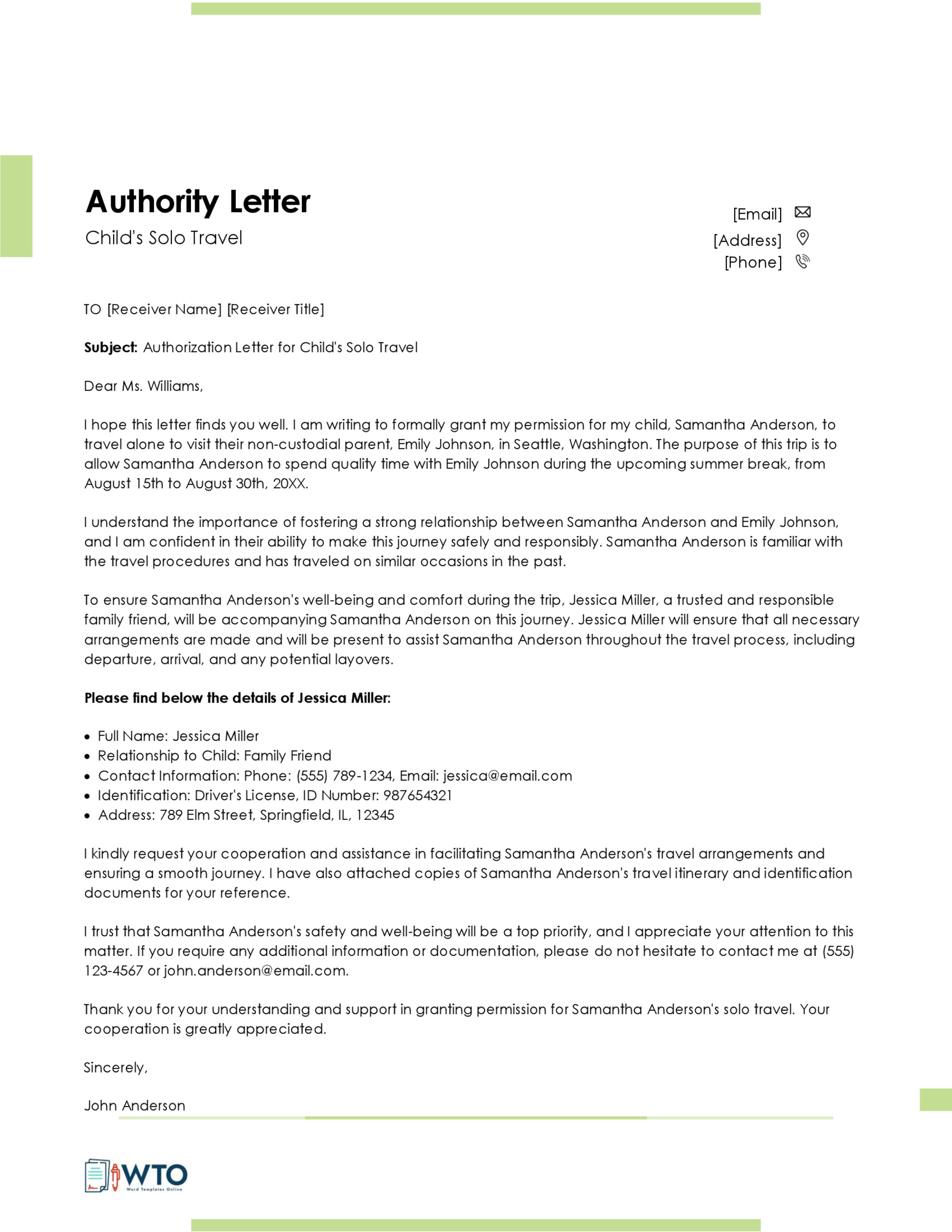

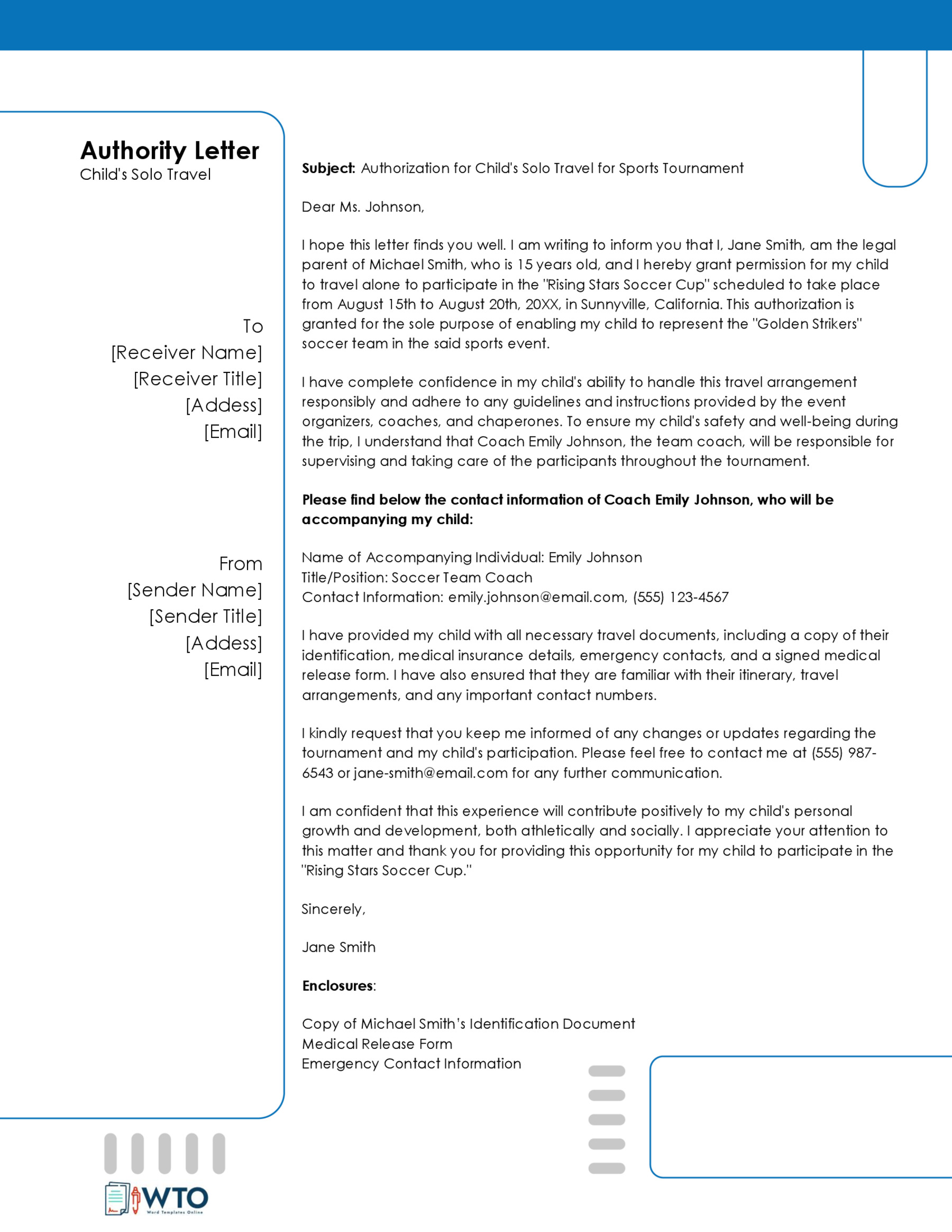
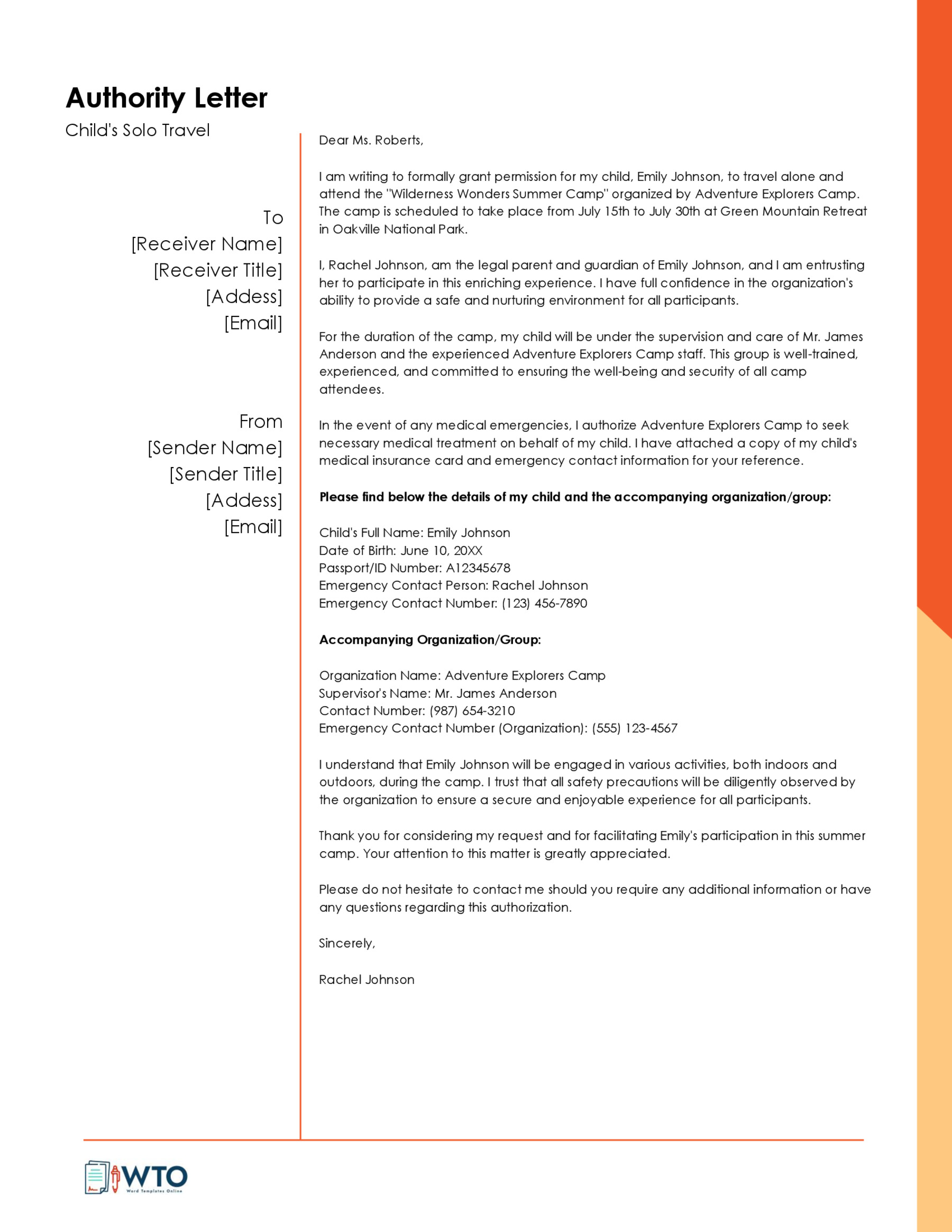

Note: Make an additional copy of the letter for your records before mailing it. A backup can be helpful in case of loss or damage to the original document. It may also provide additional proof of authorization in the future should you need it.
Frequently Asked Questions (FAQs)
The phrase “unaccompanied minor” usually refers to a child traveling alone and without the supervision of a parent or legal guardian. The age at which a child is deemed an unaccompanied minor varies depending on the jurisdiction and airline requirements. However, it typically falls between 5 to 17 years old for international flights and between 5 to 14 years old for domestic flights. For safety purposes, unaccompanied minors usually have additional requirements while traveling, such as providing contact information for the person meeting them at the destination, paying an additional fee, or adhering to specific check-in and boarding procedures. It is also important to note that different countries have varying immigration regulations, so if the unaccompanied minor is traveling overseas, they may need supporting documentation such as a copy of the birth certificate and a notarized consent letter from both parents.
It is recommended to have the letter notarized if your child is traveling internationally. Notarization usually adds an extra layer of validity to the letter, making it legally enforceable. A public notary authenticates the identity of the individual signing the letter. They also affirm that they are acting willingly and without coercion. Some countries may have different notarization requirements, and as such, you should determine the notarization requirements for the destination and those of the airline.
An authorization letter has travel details pertaining to one particular trip, including the departure and arrival dates, destination, and purpose of the trip. Therefore, you should draft a new letter for each trip if your child will be taking multiple trips. This ensures relevance to a specific journey, guaranteeing your child a smooth and trouble-free travel experience.
An authorization letter should be drafted and signed by the child’s parent or legal guardian. However, unique circumstances may arise, preventing the parent or legal guardian is unable to write the letter. In this case, they may issue a notarized statement granting someone else the authority to do so on your behalf. However, in order to ensure compliance, it is advisable to check with the relevant immigration authorities or airline before having someone else write the authorization letter.

